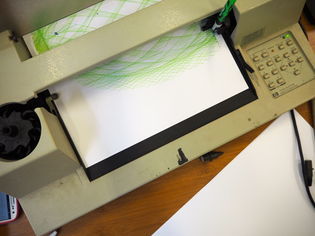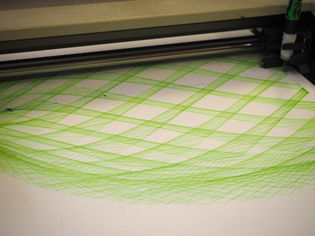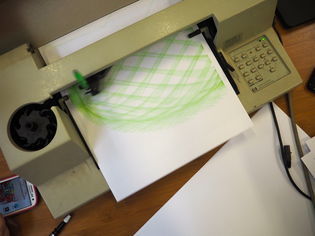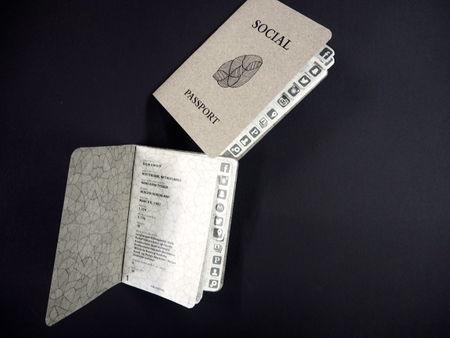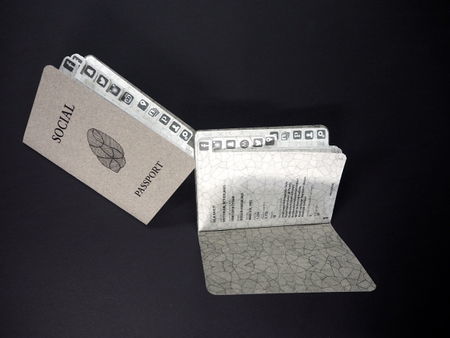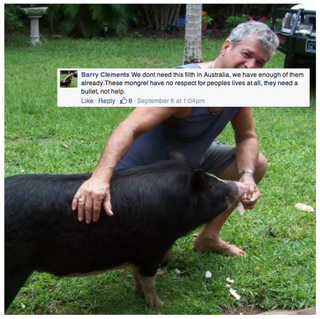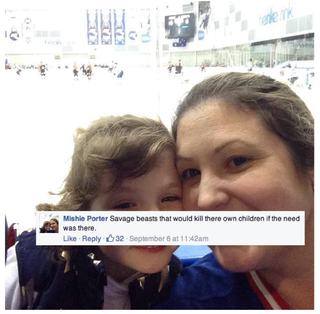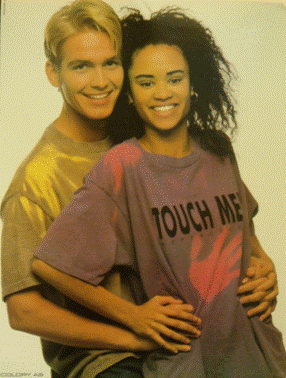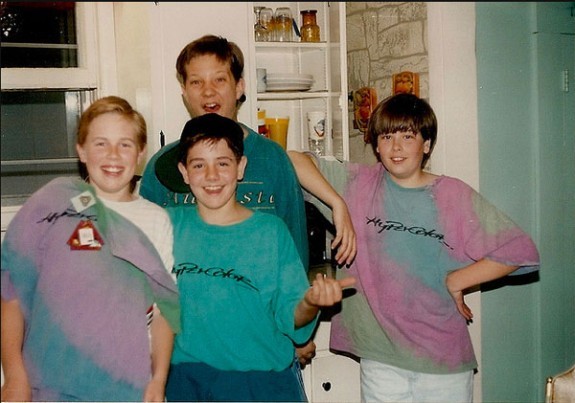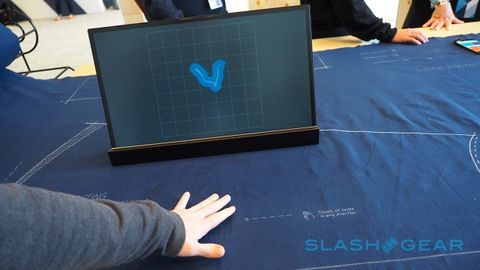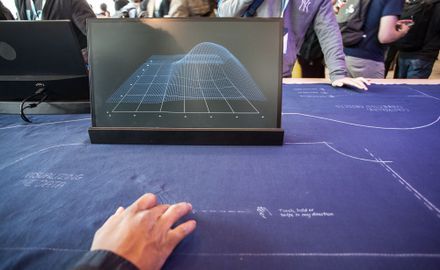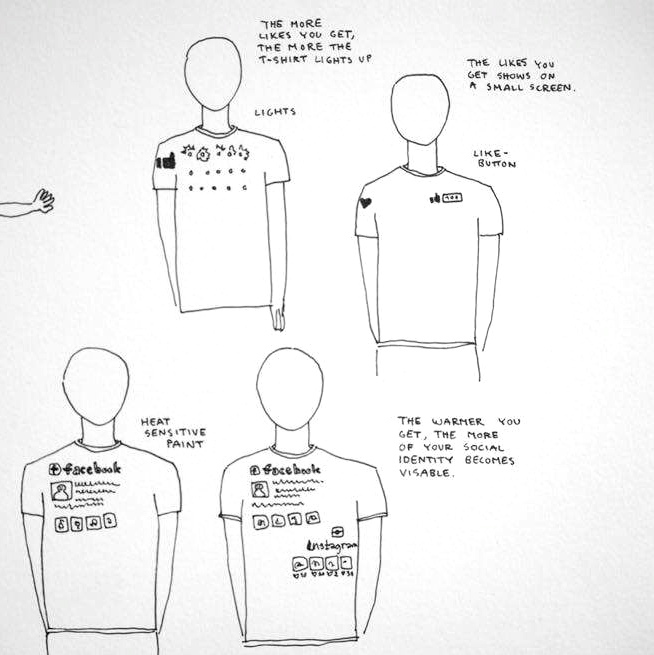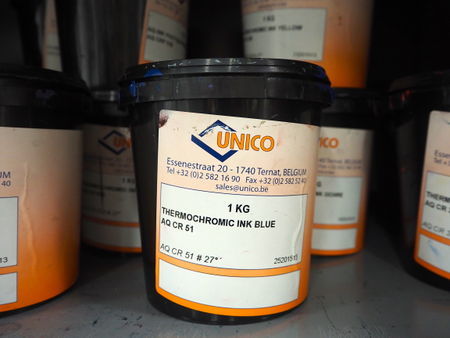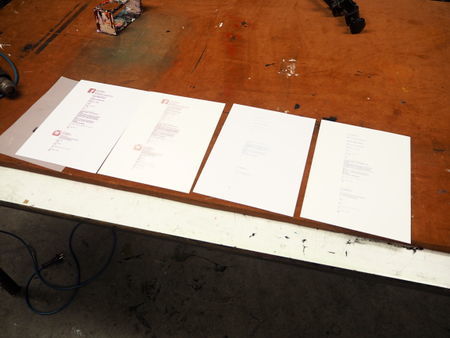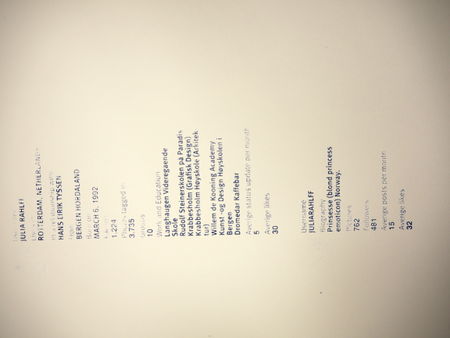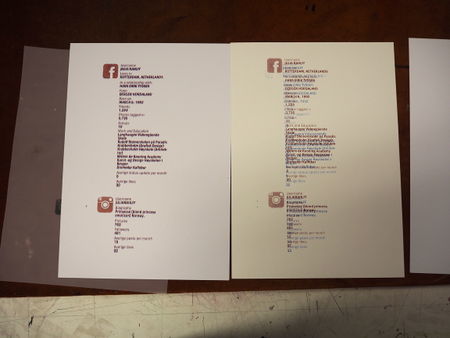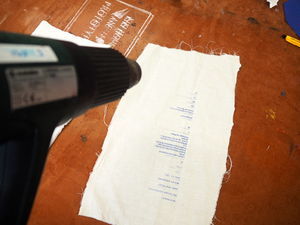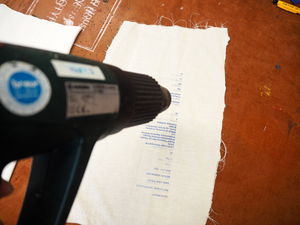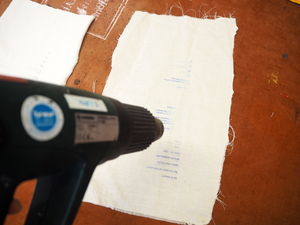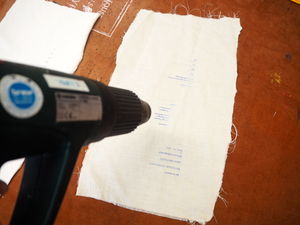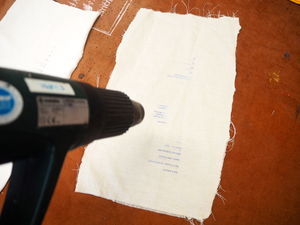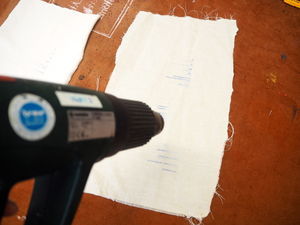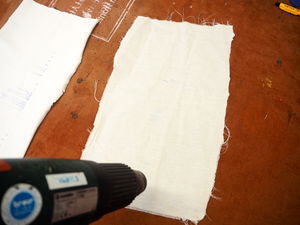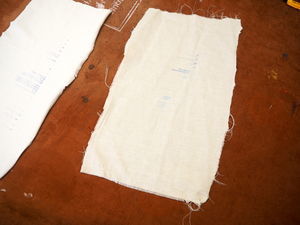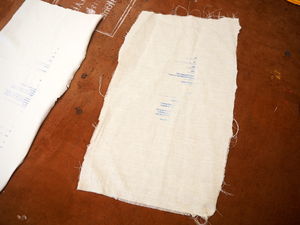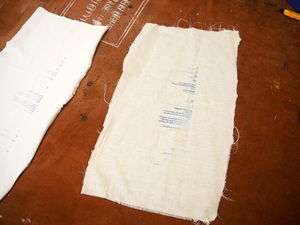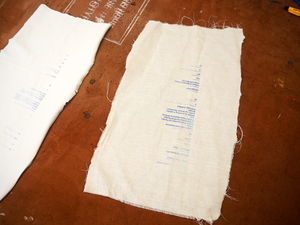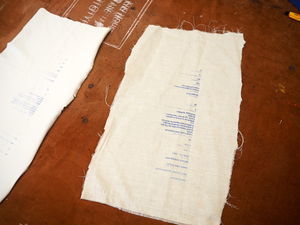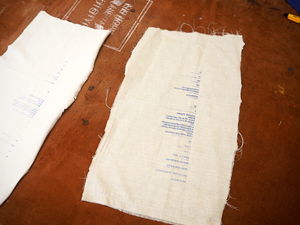Difference between revisions of "QUARTER 10 - JULIA RAHLFF"
Julia Rahlff (talk | contribs) |
Julia Rahlff (talk | contribs) |
||
| Line 92: | Line 92: | ||
My idea is that my final product is going to be a "like-T-shit", so naturally I had to test the ink on fabric. I tried two different types of fabric to see how good the ink would stick to it, and how the fabrics would react to the paint. One of the fabrics definitely worked better than the other. The smoothest and most stratchy fabric didn't accept the ink that well, and the pattern became very weak. Anyway, both of them reacted perfectly to heat, even better than it did on paper. I have a lot of videos where I use heat on these tests, but I find it hard to upload here, so I will show it underneath with pictures. | My idea is that my final product is going to be a "like-T-shit", so naturally I had to test the ink on fabric. I tried two different types of fabric to see how good the ink would stick to it, and how the fabrics would react to the paint. One of the fabrics definitely worked better than the other. The smoothest and most stratchy fabric didn't accept the ink that well, and the pattern became very weak. Anyway, both of them reacted perfectly to heat, even better than it did on paper. I have a lot of videos where I use heat on these tests, but I find it hard to upload here, so I will show it underneath with pictures. | ||
| + | |||
| + | [[File:1.JPG | 300px ]] [[File:2.JPG | 300px ]] [[File:3.JPG | 300px ]] | ||
| + | |||
| + | [[File:4.JPG | 300px ]] [[File:5JR.JPG | 300px ]] [[File:5JR.JPG | 300px ]] | ||
| + | |||
| + | [[File:6JR.JPG | 300px ]] [[File:7JR.JPG | 300px ]] [[File:8JR.JPG | 300px ]] | ||
| + | |||
| + | [[File:9.JPG | 300px ]] [[File:10JR.JPG | 300px ]] [[File:11JR.JPG | 300px ]] | ||
| + | |||
| + | [[File:12JR.JPG | 300px ]] [[File:13JR.JPG | 300px ]] [[File:14JR.JPG | 300px ]] | ||
| + | |||
| + | My ideas after doing this experiment is that I want to make two t-shirts, one where the the pattern disappears and one where it become visible. One white and one blue. On the blue one I have to first silkscreen the pattern in another color, and then cover it with the thermo ink, so that when it becomes warm, the thermo ink will become transparent and you will se whats underneath it. If this is going to work I also need a t-shirt in the same blue color. | ||
Revision as of 18:30, 7 January 2016
Reseach question:
How can I make social identity visible on people?
I want to take starting point in what I did in graphic design in quarter 9, where I worked with social identity and made "The Social Passport". This is a relevant topic because social media is becoming more and more important. People use it to brand themselves, and people judge you by your social media profile. For example its really normal for people to google you when you apply for a job, want to rent a room etc. to see who you "really" are. I think this in general is a negative thing, because its takes a lot of time to appear perfect online, it also creates a lot of pressure and a lot more of negative things, but that is a total other discussion. But on the other hand I think its positive that people can be judged by something else than their nationality, and on social media you have the ability to decide how you want to present yourself.
I want to try out different ways to transform a social medium into a pattern/fabric, and then decide for one method that I will use to make the final product. I imagine that it could either be translated into something really visual and clear (that its easy to see where the pattern comes from) or more diffuse, using for example html codes or a plotter.
I think this will be a project where I expose my own social media/online life. I will be critical about whats happening now with the increasing importance of social media, and my goal with this project will be to create reactions, conversation, and make people think.
Exploring the plotter:
PROJECT QUARTER 10
Last quarter I worked with social identity in my Graphic Design class, where I made "The Social Passport". I wanted to work further with this, because I think it is very interesting how people use social media to create a image of themselves, and "promote" their personality and looks. But also how people are getting judged by their social media profile. That people are looking at what you post online, to find out "who you really are" is a phenomenon that is getting more and more normal, for example when you are applying for a job or want to rent a room. I think this is not completely positive or negative, its positive because you have a chance to choose how you want to represent yourself, and be the "best" version of your self, and therefore purposely decide how people perceive you. You also have the opportunity to not post anything online and therefore only give an impression of who you are by meeting people in real life. But there is also a negative side to this, because your social media profile does not show how you behave in real life, and is very often carefully edited to show only your best qualities. How people perceive you online is also often depending on other people, not only you, for example on how many friends/followers you have and how many likes and comments you get. I think judging people by their social media profile is like judging people by the first impression, often based on how you look, and this impression can very easily change when you get to know people in person.
Pictures of The Social Passport, based on social media profiles and what you share about yourself online. I made these in quarter 9:
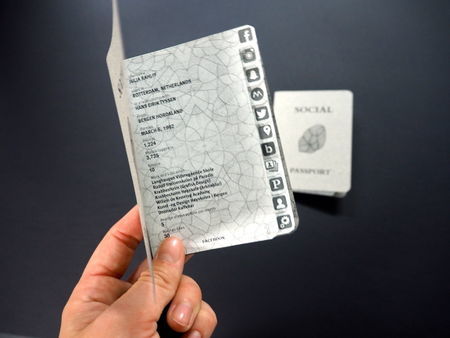
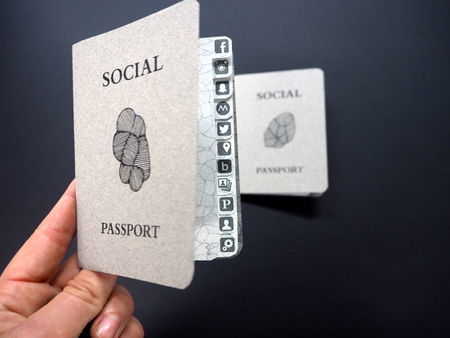
These passports makes it easier for people to see how you behave online, with these people can look browse through your social identity in a short time. To take this even further I think it would be interesting to make something wearable that people immediately see when they meet you, to intensify the feeling of being judged by your social media profile.
To press the like button or give a comment to someone or something is a relatively easy thing to do online. Since its so easy to do, posting, commenting and liking has become a part of our normal everyday life. To some extent people tend to think that they are anonymous online, and are posting things without even considering what they are saying and that it stays online forever. This has resulted in serious bullying and hatred spreading around the world. I really discovered this when I was working on the meme project last quarter, Face It. When I looked for racist meanings and horrible things people have been writing about refugees online, I was surprised to find out how big the amount of these gruesome comments are, and how easy they are found. This brought up a question: "Would people dare to say these things face to face to the people they are talking about?"
Some of the pictures from the "Face It" project:
These comments also get a lot of likes. Liking a comment, or a pictures, is even more easily done, because its just a tiny click and you don't have to write anything. I know that I tend to like a lot of pictures, because its a nice gesture and doesn't take any effort. Liking has become more effortless that actually giving someone a compliment. So then I come to the question: "Would you "like" a person in real life?" Actually go to a person and say: "Hey, I like you!"
To visualize social identity on people, I have desided to make a "like-T-shirt". I wanted to make something that you wear and walk around with, this could have been an accessorize, but I feel that a T-shirt is a good way to symbolize something you normally wear. My first idea was to make a like-button on the T-shirt, and with a little screen that counts how many likes you have, and people would also immediately see how many like you have, and then they would make up an impression of who (how popular) you are. idealistically it would only be possible for one person to press the button one time, just like on social media, where you can only like one thing once. But a screen implemented in a T-shirt is not something we would normally wear, and it may appear too weird. And just pressing a bottom may also be quite easy, so to make this more personal and intimate, I think I would like to make something that also remember how long people are touching you. I think that the longer people touch you, is a sign of how much they like you. This led me to think of another idea. To make a T-shirt that you have to like in real life, to be able to see their social identity. The social identity will appear when people like like it.
You have to like a person in real life before you get to see their social identity. So actually it is something that prevent people from judging you on your social media profile.
Researching clothing that changes color by touch:
Fabric that reacts to touch, with implemented sensors:
Sketches for the like-T-shirt:
The like-T-shirt is a t-shirt that connects the physical person to their online life.
And what you get to see is determined by the people who are around you in real life.
Notes of feedback, and what I have to think about:
Start testing with thermo ink, the T-Shirt have to be in one of the colors of the thermo ink.
What if its the opposite way around, the social id disappearing when you are hugging, because then the social identity maybe doesn't matter anymore.
Maybe have more approaches to this, make for instance 3 different T-shirt which works differently. Quantity may strengthen my project.
Make scenarios, in which situations will this work. How will people use this.
Have a plan B. If it doesn't work, at least make scenarios and prototypes.
Heat sensitive sensors exists, maybe I can use this in stead of the ink, because it takes a long time to warm up thermo ink (longer than a hug).
Intersting mixing social media (online social identity) with your real life social identity.
Aram Bartholl
STARTING TO TEST
I started experimenting and doing test with thermo ink. I chose the color blue because I think it relates to social media, obviously to Facebook, but also to other social mediums like Instagram. I also chose a thermo ink that reacts to heat by getting invisible, because I wanted to have the opportunity to make my pattern disappear, but also make it reveal a pattern behind it.
I made a test print with information I gathered on my own social media profile from Facebook and Instagram. It is quite small because I wanted to see how small letters I could make, and it would still work. I haven't decided yet if I want to have only text or images or both.
TESTS ON PAPER:
What I discovered with this test is that the heat sensitive paint is very thick, and not so easy to silkscreen print, because it gets stuck in the screen. Even though it dries very quickly, it does not react or change only by touching it. I need more heat that that. But when I used a hair dyer it worked perfectly! It was really nice to see that the text disappeared and then slowly became visible again, even though it did not react only using regular body heat.
TESTS ON FABRIC:
My idea is that my final product is going to be a "like-T-shit", so naturally I had to test the ink on fabric. I tried two different types of fabric to see how good the ink would stick to it, and how the fabrics would react to the paint. One of the fabrics definitely worked better than the other. The smoothest and most stratchy fabric didn't accept the ink that well, and the pattern became very weak. Anyway, both of them reacted perfectly to heat, even better than it did on paper. I have a lot of videos where I use heat on these tests, but I find it hard to upload here, so I will show it underneath with pictures.
My ideas after doing this experiment is that I want to make two t-shirts, one where the the pattern disappears and one where it become visible. One white and one blue. On the blue one I have to first silkscreen the pattern in another color, and then cover it with the thermo ink, so that when it becomes warm, the thermo ink will become transparent and you will se whats underneath it. If this is going to work I also need a t-shirt in the same blue color.
